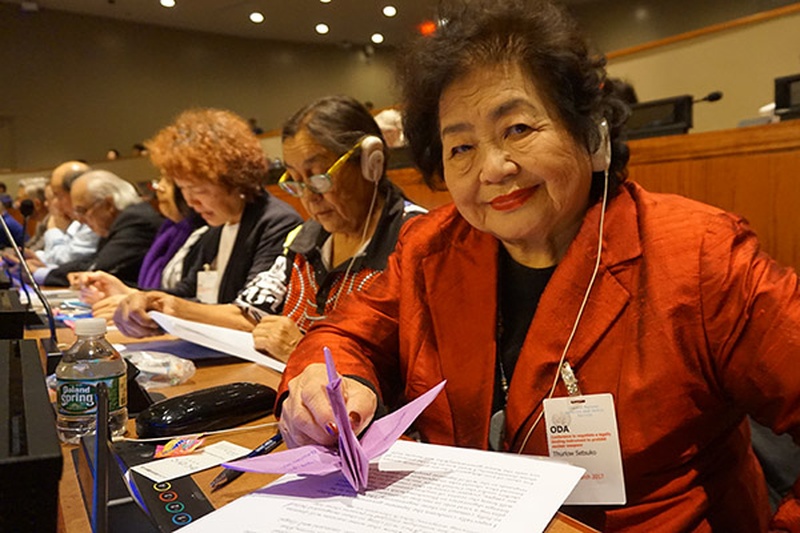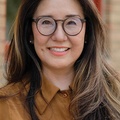At 13 years old, Setsuko Thurlow, the youngest of seven children, organized her school paper and liked to read books recommended by her older brother, play the organ with her mother and learn English with her father. But her entire life changed in a blinding bluish white flash on Aug. 6, 1945.
A hibakusha, Thurlow survived the nuclear bombing of her home, Hiroshima. She has dedicated the last 70 years of her life to advocating for the abolition of nuclear weapons. A leading figure with the International Campaign to Abolish Nuclear Weapons (ICAN), she accepted the Nobel Peace Prize alongside the organization’s executive director, Beatrice Fihn, in 2017.
Thurlow will be the main speaker for the Hiroshima Nagasaki Day Coalition’s online commemoration of the 75th anniversary of the atomic bombings on Aug. 6, starting at 7 p.m.
“I feel grateful that I had opportunities and I got more people involved, and they are able to move the government, even the world at the United Nations. Imagine. We couldn’t have envisioned that. If you believe in the truth, in something of value, you have to stick to it,” Thurlow tells Nikkei Voice in an interview.
Born in 1932, Thurlow grew up only knowing a Japan at war, the Second Sino-Japanese war, and then the Second World War. Her father was the head of the honke, the main household in the family system, and the family grew up in a big home. Her family had lived in the Sacramento area of California for 20 years with a successful farming business. Returning to Japan, shortly before she was born, Thurlow’s upbringing was a mixture of Western and Japanese culture.
At 13, Thurlow wanted to learn to play the piano and speak English, so she enrolled in a private Christian girls’ school that had a special music program. In the eighth grade she finally had the chance to start taking piano lessons, having a whole piano to herself.
“I was so excited in the new environment. Little did I know that I wouldn’t have the opportunity to learn piano,” says Thurlow.
But the piano classes were cut short when she was among 30 girls in her school recruited as cheap labour to decode messages for the Japanese army.
“We started getting lessons on how to do the decoding of secret messages. Can you imagine a 13 year old girl dealing with a top secret information?” she says.
After three weeks of training, the girls were starting their first official day of work. Listening to introductory speeches in an assembly on the second floor of a military building, Thurlow saw a blinding bluish white light encompass the window, and felt her body float up into the air before she lost consciousness. It’s a sensation Thurlow says she still feels to this day.
“When I woke up, I found myself pinned under the collapsed building in the total darkness, in the total silence, it was an eerie experience,” says Thurlow. “Then all of a sudden I started hearing whispers of the girls. They said, ‘God help me, mother help me, I’m here,’ so I knew I wasn’t alone in that darkness. I couldn’t see anyone, but I was surrounded by the girls.”
A hand grabbed Thurlow’s shoulder, shaking her, and the gruff voice of a man told her to crawl towards the light. Crawling out of the building, even though it was still the morning, the world was dark, the sky filled with soot and dust from the mushroom cloud above. The building she had just crawled out of was made of wood and was already on fire, and she couldn’t go back in. Two other girls came out with her, and the rest would burn to death.
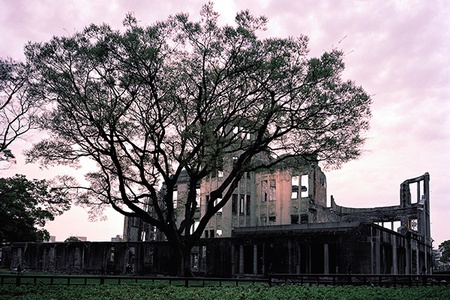
In the darkness, Thurlow could see dark shapes moving towards her, and realized it was a procession of people, burned, scarred and swollen, with their hair standing up. Thurlow says they moved like ghosts, nobody was running or screaming because no one had the physical strength left. They just shuffled out of the city. The three girls joined the ghosts out of the city, to a military base on the foot of a hill.
“We had to learn to step over the dead bodies because they were everywhere,” says Thurlow.
The explosion obliterated 90 per cent of Hiroshima and killed 80,000 people in the immediate explosion. By the end of 1945, the death toll had risen to 140,000. Tens of thousands died from their injuries in the following days or years later from radiation exposure. The exact death toll is still unknown, and people are still dying 75 years later from radiation. Three days after Hiroshima, a second bomb was dropped on Nagasaki, killing another 40,000 people.
Both of Thurlow’s parents survived the bombing. Her father was out of the city, fishing on the ocean when he saw the mushroom cloud over the city. Her mother was washing the breakfast dishes when their house fell on top of her, but luckily she was rescued. Thurlow’s older sister and four year old nephew were not so lucky. Although they had evacuated from the city earlier, they had returned to see a doctor the day before the bombing. Terribly burned, they died a couple of days later.
“Every time I think of Hiroshima, the first image I get is this four year old child, that cute little fellow, he was nothing but a chunk of flesh,” says Thurlow. “I saw so much, and all of us did, so we [hibakushas] made a vow, we dedicated our lives to ensure the death of those innocent children, innocent people was not in vain.”
Thurlow started by speaking to high school and university students, church groups, and women’s groups. Now she has spoken at U.N. conferences, to diplomats from nations around the world. She speaks to give a human face to debates that often revolve around diplomacy, weapons systems and strategic plans, as someone who witnessed the devastation of the atomic bomb firsthand.
“Human suffering continues 75 years later. And what we suffered from was a primitive, crude bomb. Today their bombs are thousands of times more destructive,” says Thurlow.
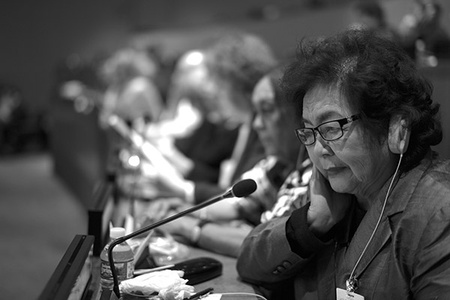
Today there are over 14,000 nuclear weapons in current arsenals, in nine countries, according to ICAN. A single nuclear weapon could indiscriminately wipe out a city, and fallout of the radiation has long-term affects on those exposed, causing cancer and birth defects, as well as lasting damage to the environment.
Thurlow’s activism took off in 1954, when the U.S. detonated a hydrogen bomb in Bikini Atoll in the Marshall Islands. She was studying sociology at Lynchburg College in Virginia, and spoke out against the act in a newspaper article. Thurlow faced harsh backlash from readers, who sent her hate mail, telling her ‘to go home’ and ‘remember Pearl Harbor.’ Scared to go out, or even go to class, Thurlow had a week of serious soul-searching.
“I couldn’t go to the classroom, of course my mind was occupied with this fear, what am I going to do? I can’t go home, but they tell me awful things. How am I going to live? Am I going to put the zipper over my mouth and pretend? It was really a traumatic experience for me,” says Thurlow. “But I’m glad I came out of that period with a decision. If I don’t speak out, who would? No survivors, nobody else who had the firsthand experience. I can tell them the truth, if they don’t like it, well too bad, I can’t make up a this story. So I kept on speaking.”
Thurlow moved to Toronto with her new husband, Canadian historian Jim Thurlow, in 1955. After a year of waiting for her parents final approval, the two left Virginia, where mixed race marriages were still illegal, and married in Washington, D.C. before coming to Canada. Jim was Thurlow’s confidant and support system for over 50 years. Together they organized numerous events and anti-nuclear groups, and even a scholarship, the James and Setsuko Thurlow Scholarship in Peace and Disarmament Studies.
On July 7, 2017, history was made after weeks of intense negotiations, when 122 nations to one, voted to adopt the Treaty on the Prohibition of Nuclear Weapons. The treaty is a categorical ban on the nuclear weapons. When the vote results came in, people around her jumped up, clapping and hugging each other, and the press swooped in to take photos of her reaction. But Thurlow was in shock, the treaty was not something she thought she would see in her lifetime, she says.
“At that moment what I did do was to communicate with hundreds of thousands of people who perished,” says Thurlow. “It may sound funny, but it’s always their image and memory in my mind. Especially when something special like that happens. I reported to them, we have come to this point. It’s not complete success, but the first step we achieved, and please wait, we will continue.”
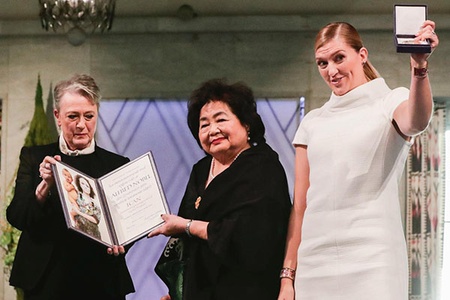
In December 2017, in Oslo, Norway, Thurlow accepted the Nobel Peace Prize with Beatrice Fihn on behalf of ICAN, for their work to get the treaty adopted. Thurlow wore one of her mother’s kimonos, refashioned into a blouse, to bring a piece of her mother with her. For Thurlow, the prize was reassurance that they were on the right path and tremendous encouragement to keep going.
Now that the treaty has been adopted, it needs to be ratified by 50 countries in order to become international law. So far 39 countries have ratified the treaty, and 11 more are needed. ICAN has campaigned to heads of state around the world, and Thurlow has written personal letters to each of those leaders, sharing her story and asking them to ratify the treaty. The nine nuclear armed states did not attend the vote to adopt the UN treaty, nor have they ratified the treaty, and neither has Canada.
In July, Thurlow wrote a letter to Prime Minister Justin Trudeau, asking him to take action against nuclear weapons. In her letter, she asks Trudeau to issue a statement of regret, acknowledging Canada’s part in the Manhattan Project, and asking Canada to ratify the UN treaty.
In 1942, the Mackenzie King government acquired Eldorado Gold Mines Ltd. for nearly $5 million. The refinery in Port Hope, Ont. was used by the Canadian government to refine uranium ore harvested in Canada and Belgian Congo, used in the Manhattan Project to create the first atomic bombs.
In 1943, Prime Minister King hosted American President Franklin Roosevelt and British Prime Minister Winston Churchill in Quebec City, where they signed the Quebec Agreement, agreeing to jointly develop the atom bomb.
By acknowledging Canada’s role in the making of the atom bomb, Thurlow hopes more Canadians will learn about its history and the real risk it still holds today. For many Canadians, the bombing of Hiroshima is an issue between the U.S. and Japan. But while nuclear weapons exist still, they affect the whole world, says Thurlow.
Until the treaty is ratified, non-governmental organizations and individuals have power, and there are lots of ways they can bring forth change, says Thurlow. Since accepting the peace prize, Thurlow has been awarded a handful of honorary degrees, including from the University of Toronto in 2019. When speaking to students, she shares her story, and encourages them to be agents of change, to contribute to society and to make change for the collective good.
At 88 years old, Thurlow shows no signs of slowing down. Before COVID-19, she was still speaking to groups around the world. As more of the hibakusha become too frail or pass away, Thurlow is still fighting.
“Hibakushas are dying, and their motto has been, and still is, nuclear abolition in our lifetime. But they have been dying away, before they see, but they still have that dream. While we’re alive, with our own eyes, we’d like to see that treaty be signed. I’m afraid it’s going to take a long time,” says Thurlow.
Watch Setsuko Thurlow giving the closing remarks at the Nuclear Ban Treaty Negotiations, UN New York on 28th March, 2017 below:
* This article was originally published on Nikkei Voice on July 29, 2020.
© 2020 Kelly Fleck / Nikkei Voice


